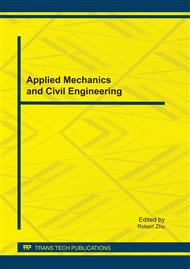p.119
p.123
p.128
p.134
p.140
p.144
p.149
p.154
p.159
Numerical Study on Effects of Rock Bridge Angle in Uniaxial Compression Test
Abstract:
Numerical specimens with two pre-existing flaws is established by using particle flow code PFC2D and by changing the relative position of the pre-existing flaws different rock bridge angle is obtained. Though the uniaxial compression test of specimens with different rock bridge angle , it can be found that rock bridge angle have a great impact on the mode of crack propagation of specimen. The different relative position between the two pre-existing flaws led to different levels of stress shielding effect under the axial force, and it is most likely to damage when the two pre-existing flaws are about overlap.
Info:
Periodical:
Pages:
140-143
Citation:
Online since:
October 2011
Authors:
Keywords:
Price:
Сopyright:
© 2012 Trans Tech Publications Ltd. All Rights Reserved
Share:
Citation:


